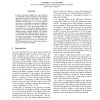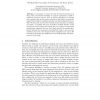PR
2006
15 years 10 days ago
2006
Fuzzy-clustering methods, such as fuzzy k-means and Expectation Maximization, allow an object to be assigned to multiple clusters with different degrees of membership. However, th...
NIPS
1998
15 years 1 months ago
1998
We present the CEM (Conditional Expectation Maximization) algorithm as an extension of the EM (Expectation Maximization) algorithm to conditional density estimation under missing ...
107
click to vote
UAI
2003
15 years 1 months ago
2003
Learning with hidden variables is a central challenge in probabilistic graphical models that has important implications for many real-life problems. The classical approach is usin...
80
Voted
ECML
2006
Springer
15 years 4 months ago
2006
Springer
Abstract. In this paper, we review the task of inductive process modeling, which uses domain knowledge to compose explanatory models of continuous dynamic systems. Next we discuss ...
IDEAL
2007
Springer
15 years 6 months ago
2007
Springer
Clustering is used to generate groupings of data from a large dataset, with the intention of representing the behavior of a system as accurately as possible. In this sense, cluster...
100
click to vote
AI
2009
Springer
15 years 7 months ago
2009
Springer
Abstract. We use a hierarchical Bayesian approach to model user preferences in different contexts or settings. Unlike many previous recommenders, our approach is content-based. We...
AI
2009
Springer
15 years 7 months ago
2009
Springer
Abstract. Version Control Systems (VCS) have always played an essential role for developing reliable software. Recently, many new ways of utilizing the information hidden in VCS ha...
84
Voted
EACL
2009
ACL Anthology
16 years 1 months ago
2009
ACL Anthology
We present an algorithm for pronounanaphora (in English) that uses Expectation Maximization (EM) to learn virtually all of its parameters in an unsupervised fashion. While EM freq...
105
click to vote
ICML
2001
IEEE
16 years 1 months ago
2001
IEEE
Data noise is present in many machine learning problems domains, some of these are well studied but others have received less attention. In this paper we propose an algorithm for ...
109
click to vote
ICIP
2002
IEEE
16 years 2 months ago
2002
IEEE
The topic of this paper is the integration of Expectation Maximization (EM) background modeling and template matching using color histograms as templates to improve person trackin...






